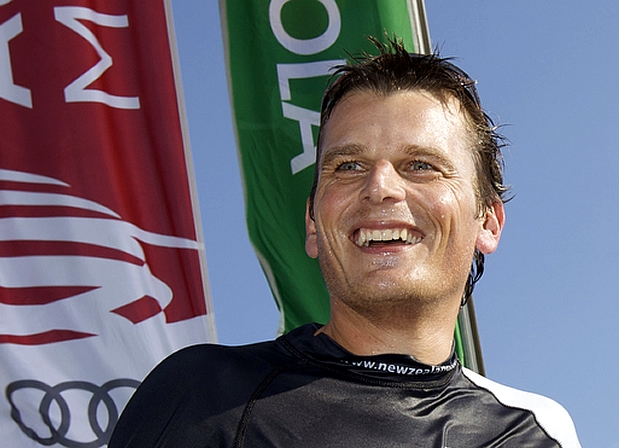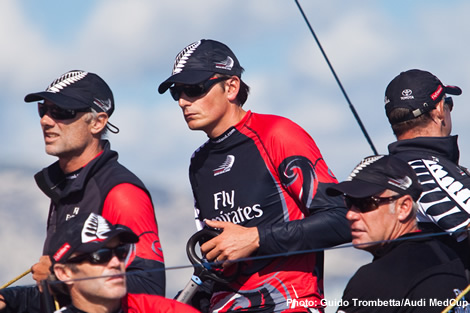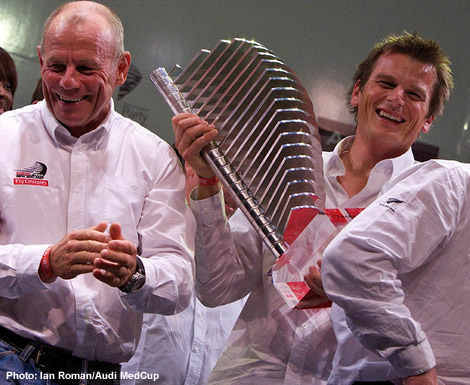AC34 - thumbs up or down?
With 14 years background in the America’s Cup, in the R&D and design not to mention the sailing side, Emirates Team New Zealand has potentially had the most to lose from the dramatic changes announced by Russell Coutts for the 34th America’s Cup.
While the announcement came as no shock - the date of 2013 rather than 2014 was more of a surprise than the choice of a catamaran - skipper Dean Barker says he is personally enthusiastic about the changes to be introduced, albeit with reservations.
Personally he is going to have to go through the same re-training process that the likes of James Spithill and Ed Baird went through in 2008, having to fast track their learning about how to sail and compete in multihulls. Barker says they are currently assessing how best to do this. “There are obviously a lot of different avenues out there with the Extreme 40s, A-Class, F18s, Tornados, etc. It is a case of trying to understand the best way to develop and then to find out how to race wingsail catamarans.”
This process is already underway. Having had no previous experience of multihull racing, apart from having competed in the Trophee Clairefontaine the French champion of champions event a decade ago, Barker has recently been having a play in an A-Class catamaran. Emirates Team NZ is lining up to participate in the final Extreme Sailing Series event of the season in Almeria over 9-12 October. As Barker puts it: “We are going to go and jump in the deep end. It’ll be great. I follow it a little bit. I’ve never done any of the racing but it will be quite interesting.”
In New Zealand they also have access to Michel Desjoyeaux’s former Geant ORMA 60 trimaran that has been bought by Simon Hull and was recently named Team Vodaphone Sailing, which is set to enter the leading Kiwi offshore race, the Coastal Classic, as well as the Round Australia, etc. However there is a clause in the Protocol that only allows boats such as this (or Extreme 40s) to be used for training by Cup teams up until April 2011.
As to whether the move to a 72ft solid wingsail catamaran means that their long legacy and hard won knowledge-base in monohulls in the Cup is now value-less, Barker reckons that this is by no means the case. “I think what we have developed in the last few years is transferable in a lot of ways into whatever event you get into, whether it be Volvo or this. It is the culture and process - those are the two things where we work very hard to keep developing, making sure you have the right people on the design and sailing team. Obviously they won’t be exactly the same, but what you do see is that a lot of the top monohull sailors from both Oracle and Alinghi have made the transition very well to the multihull environment.”
As a team they have also anticipated the move to catamarans and have been adding to their design resource. Of course they have a significant link to the aerospace industry that will benefit them in their wing design through their main sponsor Emirates Airlines, which Barker says has ties with Airbus.
“It actually makes you want to get out of bed and learn to sail these boats, so I am very excited by it,” says Barker of the prospect of racing the AC72 cat. “The things that Oracle have been saying about a consultative process and an open affair, I don’t necessary buy that, because you have to say they have created something that is very heavily stacked in their favour. They have kept the rule fairly restricted in a way that means that they are not going to get shocked by some team that comes out with something from left field as it probably prevents team making any major technological break-throughs as well.”
So despite holding this significant advantage BMW Oracle Racing is beatable? “I think with hard work you are going to give yourself a chance, but there is no doubt they have got a head start. It is whether in the three years you have got you can make up the differential. You wouldn’t get involved in the process unless you truly believed that you could.”
The AC45s that are to be used for regattas in 2011 are being built in New Zealand, so potentially the Kiwi team are in a better position to keep an eye on those, but here again Barker reckons their creation will benefit Coutts’ team as it is another opportunity for them to design and build a wingsail multihull that the challengers won’t have.
In terms of racing the AC45s, Emirates Team NZ like everyone else is in the dark over the schedule for the program that won’t be announced until the end of the year. “So that is hard. We don’t even know what the America’s Cup race course will be until a month before we launch our first boat so you say that doesn’t seem quite right either. But when you haven’t won it you can’t make the rules...”
Perhaps the greatest concern is the campaign budgets. Barker is under no illusion that it will be more expensive than the 32nd America’s Cup. “If you look at what is involved if you want to go out there and build eight wings and ten daggerboards and two boats and do everything properly which you are going to have to do to have a chance of winning, I struggle to see how it would be cheaper.”
The problem is what would you do differently to make it cheaper? True, there are no sail periods but presumably even throughout these sailing team members will still be paid a salary or at worst a retainer. Barker reckons that with the move to catamarans limiting teams to building just one boat wouldn’t be sensible. “It needs to be two boats because you are going to learn from the first boat and with this type of sailing there is no guarantee that one boat is going to make it all the way through...”
There are possible savings through the rule that designers are under no obligation to ‘go exclusive’ with teams until 1 April 2012. However Barker is of the opinion that this will be of most benefit to smaller teams. “If you are a serious team you are going to want your own design group and as soon as you put a boat in the water you are going to want to develop it as best you can all the way through. But a smaller team has the opportunity to go and buy a design off the shelf and then probably be reasonably close to being on the pace.”
So in general terms is the America’s Cup defender has behaved well or outrageously? “To be fair they have put something down that is transparent, it is certainly not completely one sided and that is all you can hope for. In terms of them being consultative with all the teams – they haven’t...”
The proof of whether Coutts’ initiative has worked will be in the number of teams that sign up at the close of the entry period, says Barker. “The proof will be in the pudding in March next year when we will know how many teams really believe it is better and everything else. Evidence would suggest that there would have been eight or ten teams in a normal format [ie monohull] and whether we get close to that is anyone’s guess. They have to be careful that they don’t try to reinvent something that wasn’t actually broken. You can argue that the [V5] boats were dinosaurs and everything else, but there were still opportunities to make the boats more interesting. The RC44s have been a great success and that in a bigger format would have been quite spectacular. But between Larry [Ellison] and Russell [Coutts] they made a decision and that is their right and but if they are wrong it could damage the sport for everyone.
“We are sad in a lot of ways because the flow of technology that came from the class and the sails and sail development, the rigging - is just no longer applicable. It is hard to imagine a fleet of TP52s sailing around with wingsails. You wonder if it is too extreme. But we will probably be sitting there in 2013 wondering what all the fuss was about. There is one thing you can be sure of: it will be exciting.”
Having won the Audi MedCup in 2009 and looking set to repeat this in 2010, Emirates Team New Zealand look set to withdraw from the TP52 circuit after this year, despite Barker saying that he still loves the circuit. Their Botin & Carkeek TP52 was sold at the beginning of the year to Australian Marcus Blackmore, best known for campaigning the Farr 40 Emotional Hooligan. Blackmore wants the boat to compete under IRC in Australia, where there are already eight or nine former TP52s.
In the meantime Emirates Team New Zealand, like all the other challengers, waits to hear what they will be doing in 2011 and beyond.














Latest Comments
Add a comment - Members log in